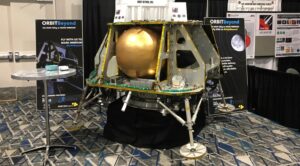Commercial lunar lander company terminates NASA contract

WASHINGTON — One of the three companies NASA selected less than two months ago to carry payloads to the moon has informed the agency it won’t be able to perform that mission and has terminated its nearly $100 million contract.
NASA announced July 29 that OrbitBeyond informed the agency that “internal corporate challenges” will prevent it from carrying out a task order that NASA awarded the company May 31 as part of its Commercial Lunar Payload Services (CLPS) program. The company asked to be released from that contract, and NASA agreed.
NASA didn’t elaborate on what specific issues caused OrbitBeyond to scrap its contract with NASA, and the company didn’t immediately respond to a request for comment. At the May 31 event where NASA announced the contracts, Siba Padhi, chief executive of OrbitBeyond, said the company was still in the process of closing a round of funding. The company has not subsequently announced a funding round.
OrbitBeyond received CLPS task orders along with two other companies, Astrobotic and Intuitive Machines. OrbitBeyond had planned to go first, launching its Z-01 lander on a SpaceX Falcon 9 in September 2020. The other companies are planning 2021 lander missions.
OrbitBeyond, headquartered in Edison, New Jersey, said it planned to build its landers at a facility in Florida. The company attracted scrutiny, though, since it was making use of technology developed by TeamIndus of India, a former competitor in the Google Lunar X Prize.
“While this partnership appears to comply with NASA’s solicitation, the optics, obviously, are not good,” Rep. Brian Babin (R-Texas) said during a June 11 hearing of the House Science Committee’s space subcommittee. Thomas Zurbuchen, NASA associate administrator for science, responded that the agency would do a “full review” of all companies that received CLPS awards to ensure they complied with a contract provision that requires the landers to be built in the United States.
OrbitBeyond received a $97 million task order for its lander mission, the largest of the three given out by NASA in May. That mission was to carry up to four payloads, but NASA at the time had not assigned specific payloads to each lander mission. A NASA spokesperson did not immediately respond to questions about how much, if any, money the company received prior to award termination.
OrbitBeyond was one of nine companies NASA selected last November for the CLPS program. The agency said that the company will be eligible to compete for future task orders, with the next opportunity to complete expected in late summer or early fall, according to industry officials.
NASA officials like Zurbuchen had emphasized since the beginning of the program that there were risks involved with the program. He emphasized the desire to take “shots on goal” with the expectation that not every shot would make it into the goal, or every mission make a successful landing, although that emphasis was more on technical rather than financial risks.
“We know that CLPS missions are going to be challenging for various reasons, and they may not always succeed,” Zurbuchen said in the NASA statement. “We’re willing to accept some risk in order to get back to the moon quickly, with commercial partners, and do exciting science and technology development with broad applications.”
NASA is also planning an “on-ramp” for the CLPS program to add new companies. The plans, announced in a June 20 presolicitation notice, puts an emphasis on “mid-size” landers capable of delivering 350 to 1,000 kilograms of payloads to the lunar surface. The agency updated that notice July 29 with a series of questions and answers, but has not issued a formal request for proposals yet.
from SpaceNews.com https://ift.tt/2MorAqD
Comments
Post a Comment